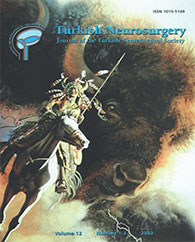2Departments of Radiology, Fırat University, School of Medicine, Elazığ Turkey Objective: Predicting the age of subdural hematomas on computed tomography (CT) scans is particularly significant for forensic reasons, and for understanding the lesion's natural history, pathogenesis, and morphology. A case of mixed-density subdural hematoma on CT is discussed, and the classification of subdural hematomas based on hematoma density, morphology, and histopathology is reviewed.
Methods: A 19-year-old male was admitted to the Department of Infectious Diseases in our hospital 20 days after he had sustained head trauma. The presenting symptoms were headache, fever, vomiting, and intermittent agitation, and he was tentatively diagnosed with meningitis. Cranial CT revealed a left frontotemporoparietal subacute hypoisodense (mixed-density) subdural hematoma. Burr-hole drainage on the same day revealed no neomembranes, and follow-up CT on the fifth day of hospitalization confinned complete removal of the hematoma.
Results: The lesion was diagnosed as a Yamashima-Type 2 isodense subdural hematoma, and septation, organization, and retraction were identified as the main steps in the pathological process. The mixed density was not considered to reflect a rebleeding-resolution process.
Conclusion: The exact age of subdural hematomas can only be determined by histopathological investigation. Distinct pathogenetic mechanisms occur in the different morphologic types, and these are reflected in the microscopic findings.
Keywords : Attenuation coefficient, head injury, hematoma age, hematoma classification, hematoma density, subdural hematoma




